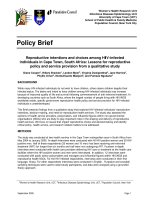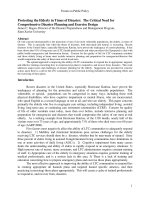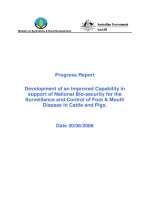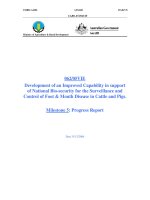Managing in times of change 24 lessons for leading individuals and teams through change
Bạn đang xem bản rút gọn của tài liệu. Xem và tải ngay bản đầy đủ của tài liệu tại đây (1006.75 KB, 83 trang )
“When change affects an organization, the
leaders of the organization—from the top
executive to line supervisors—need to
demonstrate leadership skills as never
before. The role of the manager becomes
critical in leading teams and employees
through the change process so that the
organization can implement new ideas,
and maintain its customers while retaining
and engaging talented employees.”
This page intentionally left blank
“Significant organizational change has
a powerful impact on people. Change
creates a tension between the past and the
future, between stability and the unknown.
Despite business rationale, logic, creativity,
planning, and strategies associated with
change, this tension comes down to people
doing different things in different ways.
Asking people to change behavior on
behalf of organizational goals creates
an automatic emotional reaction.”
This page intentionally left blank
Managing in
Times of Change
24 Lessons for Leading
Individuals and Teams
through Change
M I C H A E L D. M A G I N N
McGraw-Hill
New York Chicago San Francisco Lisbon
London Madrid Mexico City Milan New Delhi
San Juan Seoul Singapore Sydney Toronto
Copyright © 2005 by The McGraw-Hill Companies, Inc. All rights reserved. Manufactured in the United
States of America. Except as permitted under the United States Copyright Act of 1976, no part of this
publication may be reproduced or distributed in any form or by any means, or stored in a database or
retrieval system, without the prior written permission of the publisher.
0-07-149027-2
The material in this eBook also appears in the print version of this title: 0-07-144911-6.
All trademarks are trademarks of their respective owners. Rather than put a trademark symbol after every
occurrence of a trademarked name, we use names in an editorial fashion only, and to the benefit of the
trademark owner, with no intention of infringement of the trademark. Where such designations appear in
this book, they have been printed with initial caps.
McGraw-Hill eBooks are available at special quantity discounts to use as premiums and sales promotions,
or for use in corporate training programs. For more information, please contact George Hoare, Special
Sales, at or (212) 904-4069.
TERMS OF USE
This is a copyrighted work and The McGraw-Hill Companies, Inc. (“McGraw-Hill”) and its licensors
reserve all rights in and to the work. Use of this work is subject to these terms. Except as permitted under
the Copyright Act of 1976 and the right to store and retrieve one copy of the work, you may not decompile, disassemble, reverse engineer, reproduce, modify, create derivative works based upon, transmit, distribute, disseminate, sell, publish or sublicense the work or any part of it without McGraw-Hill’s prior
consent. You may use the work for your own noncommercial and personal use; any other use of the work
is strictly prohibited. Your right to use the work may be terminated if you fail to comply with these terms.
THE WORK IS PROVIDED “AS IS.” McGRAW-HILL AND ITS LICENSORS MAKE NO GUARANTEES OR WARRANTIES AS TO THE ACCURACY, ADEQUACY OR COMPLETENESS OF OR
RESULTS TO BE OBTAINED FROM USING THE WORK, INCLUDING ANY INFORMATION
THAT CAN BE ACCESSED THROUGH THE WORK VIA HYPERLINK OR OTHERWISE, AND
EXPRESSLY DISCLAIM ANY WARRANTY, EXPRESS OR IMPLIED, INCLUDING BUT NOT
LIMITED TO IMPLIED WARRANTIES OF MERCHANTABILITY OR FITNESS FOR A PARTICULAR PURPOSE. McGraw-Hill and its licensors do not warrant or guarantee that the functions contained
in the work will meet your requirements or that its operation will be uninterrupted or error free. Neither
McGraw-Hill nor its licensors shall be liable to you or anyone else for any inaccuracy, error or omission,
regardless of cause, in the work or for any damages resulting therefrom. McGraw-Hill has no responsibility for the content of any information accessed through the work. Under no circumstances shall
McGraw-Hill and/or its licensors be liable for any indirect, incidental, special, punitive, consequential or
similar damages that result from the use of or inability to use the work, even if any of them has been
advised of the possibility of such damages. This limitation of liability shall apply to any claim or cause
whatsoever whether such claim or cause arises in contract, tort or otherwise.
DOI: 10.1036/0071449116
Professional
Want to learn more?
We hope you enjoy this
McGraw-Hill eBook! If
you’d like more information about this book,
its author, or related books and websites,
please click here.
For more information about this title, click here
Contents
Managing in times of change
viii
Personally refocusing for managers:
Understand how change affects you
Understand the “from-to”
Choose a productive response
Seek the opportunity
Gather your assets and resources
Forge personal goals
Walk the talk
Make friends with ambiguity
3
5
7
9
11
13
15
Lead the team through:
How adaptable is your team?
Paint a picture of what is happening
Build new rules for a new game
Remember what is still important
Improvise, adapt, adjust
Measure and celebrate progress
Hold the team accountable
Squash the rumor mill
Get team members involved
Reward the team for progress
19
21
23
25
27
29
31
33
35
Show a path to individuals:
Help people get unstuck
Understand natural reactions to change
Customize help for struggling individuals
Offer empathy
Actively surface dissatisfaction
Pinpoint the positives for individuals
Tailor positive tasks for individuals
Encourage individuals to let go of the past
Stand up for people if they are right
vii
39
41
43
45
47
49
51
53
✓Managing in times
of change
A basic fact of business life is that an organization either changes or
withers away. Look at the powerhouse companies in today’s world.
Where were they 10 or 20 years ago? Have they grown, changed business models, or emerged from nowhere? What’s happened to some
of the brand names with which you grew up? Which established airlines, banks, car companies, or heavy manufacturing companies have
struggled to match lower cost, more efficient competitors? It’s either
nimbly and creatively adapt with new products, processes, and business ideas or go into marketplace decline.
Whether a company is on the upside of the growth curve or fighting to survive, one thing is common: The people working within
those organizations are experiencing change in a very personal way.
Employees have to stop what they have been doing and work in different ways with different—or fewer—team members. They may have
to work away from home more frequently or move to another facility in a strange, new city. They have to work with new technologies
that require new skills, say new things to customers, meet with each
other more or less frequently, or do more with less.
When people face these kinds of dramatic changes in the way
they live and work, the reaction can be negative and unproductive.
viii
Copyright © 2005 by The McGraw-Hill Companies, Inc. Click here for terms of use.
What had been predictable and stable at work is now replaced by
confusion, vagueness, and uncertainty.
When change affects an organization, the leaders of the organization—from the top executive to line supervisors—need to demonstrate leadership skills as never before. The manager becomes critical
in leading teams and employees through the change process so that
the organization can implement new ideas and maintain its customers
while retaining and engaging talented employees.
The managers of an organization provide the bridge from the
old way of doing things to new work practices. Paradoxically, these
managers are also employees who experience the same reactions as
everyone else. How can a leader lead when he or she may be uncertain and uncomfortable about the future?
There are productive behaviors that a manager can learn to cope
with change and to help others through. These behaviors can be
clustered into three major themes:
Personally refocus for managers. The first step in helping others
implement change is to help yourself. Managers need to understand
how they are personally reacting and how change is affecting them.
Once they understand their reaction, they can adapt to their role.
Lead the team through. A work group needs strong leadership to
provide direction, a degree of clarity, and sense of progress when
there aren’t clear answers to questions and rumors begin to fly. The
manager needs to help the team adapt to and cope with newness.
Show a path to Individuals. Individuals react to change in different
ways. Until a change has taken root within a work group, some individuals may need extra coaching and advice on how to cope. The
manager needs to sit with employees with strong, unproductive reactions to change to instill a firm, optimistic picture of the future.
“I was always for change until it happened to me.”
Midlevel financial services manager
ix
This page intentionally left blank
“Personally refocusing asks the manager
to examine personal feelings, motives,
and assumptions about change. It is
the place to start understanding how
to be a change leader.”
PERSONALLY REFOCUSING FOR MANAGERS:
Understand how change affects you
Significant organizational change has a powerful impact on people. Change creates a tension between the past and the future,
between stability and the unknown. Despite business rationale, logic,
creativity, planning, and strategies associated with change, this tension comes down to people doing different things in different ways.
Asking people to change behavior on behalf of organizational goals
creates an automatic emotional reaction.
Managers are certainly not immune from this response. Even
managers responsible for implementing change within an organization can subtly undermine that change through the words they use
to describe it and what they do to support it.
To be a successful leader of change, a manager has to first understand the dynamics of change and the ways uncertainty affects them
and others. The old way has to be mourned; the new way has to be
understood. The change leader has to recognize how ambiguity can
be used to adapt to changes, how improvisation forces work units to
make the best of their situations, and how change ratchets up the
need for clear, crisp communications.
Most important of all, the change leader has to see himself or herself as the role model toward whom all team members look for cues
and clues about how they should respond to the changing situation.
Personally refocusing asks the manager to examine his or her
individual feelings, motives, and assumptions about change. It is the
place to start understanding how to be a change leader.
“I can’t change the direction of the wind.
But I can adjust my sails.”
Anonymous
Copyright © 2005 by The McGraw-Hill Companies, Inc. Click here for terms of use.
Stop at the headlines
✓Understand the
“from-to”
Organizational change can be defined in a simple way. Change happens when the organization is moved from the status quo to something different. “From-to” is the change. “We are going from being
individual cost centers to regional profit centers.” “Our managers are
transitioning from administrators to revenue managers.” “We are moving from being a high-service, high-cost provider to being the low-cost
market leader.”
While this strategic description of change is a useful start, it doesn’t
help a work unit manager to really understand what will happen to him
or the members of the team at the grass roots level.
A critical part of personal refocusing is actually being able to
trace what the from-to will be in a work unit. Once the manager
understands that impact, she can better understand it herself and be
better able to explain it to the team.
The process of understanding the from-to is answering a series of
questions about the organization. Bear in mind, you may not be able
to answer all of these items initially. That’s what makes for ambiguity, a key by-product of the change experience.
Start with the mission: Why is the organization here in the first
place? Has that objective changed? What about those you serve? Are
your customers different? Most likely, your approach or strategy will be
different. What you do to serve your customers may be shifting from,
say, a centralized focus to a regional orientation where decisions about
customers are made in the field instead of the home office.
3
Copyright © 2005 by The McGraw-Hill Companies, Inc. Click here for terms of use.
How about how success is measured? Are old standards being
replaced by new standards? Are different kinds of measures now in
place that seem unfamiliar or even difficult to grasp, such as customer loyalty? Changes in measurements and standards can often be
a source of anxiety from employees because compensation is most
likely tied to these new success indicators.
What about how work actually gets done? Are there new processes to install and implement? Will new or fewer people be asked to do
the work? Will the work unit gain or lose tools and resources? Will
the team be managed differently? What will be the role of the managers in the new from-to environment? Will they have to become
player-coaches, maintaining their own personal individual accounts
or contributor workload or will they have to give up their individual
work entirely and manage all the time?
How will the work unit adapt? On what will the team have to
focus, or of what will it need to do more or less? What will stay the
same?
When a manager can answer these questions as completely as
possible, the extent and impact of the from-to change will become
clearer.
Analyze what is happening. Take a step back and think through
the implications of the change. When thinking about different
aspects of work, keep asking yourself, “How will this be affected?”
Isolate the big impacts. Every change usually has at least one—
usually more—major implications for how things operate. Locate
what those are.
Use your imagination. The impact of many of these changes is
unforeseen at the planning stage. Keep your mind open to what
might happen and how people might feel.
“It isn’t the changes that kill you; it’s the transitions.”
William Bridges
4
Dive for cover
✓Choose a productive
response
Change happens to us every day. We miss our usual train to work, the
highway has a detour, the weather is colder or hotter than we thought,
we have a new email system, we have to submit time sheets, we are
asked to sign up for meeting room reservations, we have to change our
schedule because someone can’t make a meeting. Countless little
events make our days different from one another. Some of these cause
us to change or stop our usual behavior, causing irritation and grumbling. “Why should we make meeting room reservations now? We
never had to before.” Others are just absorbed into our routine. By the
second day, the road detour has become familiar, we find we can do
neat things with the new email system, and so life goes on. We learn,
we adapt, we continue with what was once unfamiliar.
On the other hand, there are changes that come along, usually
once in a while or once in a career, that cause big discomfort and
major stress. Our company has merged with another; we are not sure
who will be asked to continue working. We have a new manager who
is more demanding. Our work group has been asked to move out of
town. A favorite work colleague, friend, and mentor has retired, and
no one is replacing her. You have to do your job and part of someone else’s job. The compensation system has been changed.
All of these powerful changes contain an underlying loss. Gone
is our comfort zone. Gone is the predictability and certainty of the
past. We don’t know what to expect. We feel at odds with the future;
our sense of security goes down. At the root of this sense of loss is
5
Copyright © 2005 by The McGraw-Hill Companies, Inc. Click here for terms of use.
fear. That is what makes it so difficult to deal with change. People
become fearful when certainty goes away.
One way to react to this kind of change is to respond unproductively. Typically, that response is a natural defensive reaction and not
usually made on purpose. Withdraw into a private world and take
caution in what you say and to whom you say it. Play the disenchanted employee (“Things were better back when . . .”); refuse to make
decisions until information is totally complete and accurate; overreact or feel powerless (“There’s nothing I can do about that”).
Yet, there is a more productive way to react to change.
Acknowledge your loss, yet make a conscious decision to cope and
remain positive and productive. The merger situation may result in
greater opportunities, or you may meet interesting colleagues and
learn more about your profession. Show creativity in muddling
through situations that aren’t completely clear; test your experience
and intuition by making decisions as best you can.
Pressing on the positive switch is an important first step for a manager responsible for getting results from people. Consider these ideas:
Recognize your unproductive response. If you find yourself resisting
the change, or seeing only the negative aspects of it, reflect on how
you are feeling about what has happened and what will happen.
Unproductive reactions include withdrawal, denial, and overreacting.
Cope. To cope means to make the best of your situation.
Recognize the difficulties you are facing and decide to deal with
them in a positive way.
Be yourself. Change is going to happen regardless of what you do.
Let go of the past and get ready to move on. This adjustment isn’t
always easy, but it is necessary.
“The illiterate of the 21st century will not be those who
cannot read and write, but those who cannot learn,
unlearn, and relearn.”
Alvin Toffler
6
Emphasize the obstacles
✓Seek the opportunity
Here is an interesting exercise: Think of a change that is affecting
your organization or team. From the organization’s point of view,
identify what the positive as well as negative consequences of that
change will be. Now, from your individual perspective, list what you
feel are the positive and negative outcomes. Review your responses.
Chances are the list of negative outcomes for you is as long as the list
of positive outcomes for your organization. Typically, many people tend
to see organizational change as first and foremost benefiting the organization, not the people who work there. For example, if the organization
is moving its headquarters to a suburban location from a downtown area,
the business positives include lower expenses, expandable space, better
communication among departments that will now be in one location, tax
benefits, and so on. Employees, however, may view this impending move
as nothing but bad news: They may have a longer commute, a need to
buy a car, more time away from family, uninteresting lunch options, and
a change in the “feel” of the company. Yet, if you think about it, the new
location will have more room, better lighting and furniture, more exposure to others in the company, a gym, and outdoor tables for meetings or
lunch. The personal opportunity is to work together more effectively, get
some exercise, and have a better total work experience.
The point is that we tend to see personal negatives before we see
the positives in a change situation. When it comes to personal refocusing, a manager needs to look objectively at the change situation
to determine what positives there are either actually or potentially
for him- or herself. The key is to look beyond your first reaction.
7
Copyright © 2005 by The McGraw-Hill Companies, Inc. Click here for terms of use.
Where is the opportunity? Imagine your organization is moving
to a team concept in dealing with clients. Instead of individual specialists calling on a client, the individual specialists have become a
coordinated team, calling on clients in a systematic way, presenting
integrated solutions that solve a number of client problems rather
than one or two at a time. While that approach initially looks as if
you are no longer an individual “star” in the eyes of the client, the
opportunity is to creatively work with other professionals, develop
innovative approaches, and learn how other professionals think.
If your new manager is asking your team to take on new tasks, the
opportunity is to get your team to discuss how it can work more effectively, an effort and challenge you can lead. If your group is being
merged with another group, the opportunity is to create a seamless
transition so that details, time, and expenses are not lost. If the
group has new government regulations to implement, the opportunity is to train and motivate the team to make it happen.
Find the rainbow. Think carefully about where the opportunity
might be in the change situation. Where can you shine? What can
you learn? What impact can you make?
Banish negative thinking. Don’t let obstacles appear so large that
they stop you from seeing the opportunity that change represents. If
you find yourself dwelling on the negatives, ask yourself why, and
switch your perspective.
Look for the critical success factor. Any change is going to involve
something special—coordination, motivation, teamwork, technical
skill, leadership. Put yourself in a position to deliver what is needed.
“Opportunity is missed by most people because it comes
dressed in overalls and looks like work.”
Thomas Edison
8
Go it alone
✓Gather your assets
and resources
It’s clear that managing change in a work unit is a challenge. Many
managers feel as if they are pushing change and dragging team
members along to a new way of doing business, especially when the
change is dramatic, such as taking on additional tasks, working with
new partners, or changing work hours.
As part of the personal refocusing process, the wise manager
needs to identify the tools and resources available to help him or her
succeed. Without taking inventory of these assets, the manager can
feel isolated when working through change.
What are these tools and resources? The manager’s manager is
probably the most important one. The “boss” has links to higher levels of the organization where different types of decisions are made
and where information begins its downhill flow. The manager’s manager can be a skill coach, a source of answers as well as a sounding
board for ideas before they are implemented in the work unit.
A manager’s personal network within an organization is also a
vital resource. These are relationships outside formal reporting
structures. The people in a personal network are colleagues, former
managers, mentors, and friends who can be counted on for help,
information, and ideas. A manager can also use this back-door, informal network to get things done. For example, if a manager feels a
newly merged work unit needs a special brand of teambuilding activity, he or she can access network friends who can recommend or
even provide a training session.
9
Copyright © 2005 by The McGraw-Hill Companies, Inc. Click here for terms of use.
A more tangible resource is training or reorientation programs.
Most big changes in a company are supported by a variety of communications efforts—such as town meetings or frequently published
newsletters and updates. Some change programs include teaching
employees new skills to work in the changed environment. A company that is moving to a sales orientation, for example, will train engineers and technicians in customer service skills. A manager needs to
understand what the organization is providing, what the purposes of
these different elements are, and how he can take advantage of them.
Finally, an often-overlooked resource is the rationale for the change
itself. A manager has to be able to understand and clearly and convincingly articulate the driving vision of the change and the opportunities it
represents. This goal can help the team accept what is happening and
why. “We are downsizing so we can focus on what we do best for the customer. Everyone is going to have a lot more experience in solving customer problems.” “We are merging with a larger company so that we can
gain technological resources and marketing strength that will widely distribute our products to new markets.” The big picture sets the context
for why individuals will be asked to do new and different things.
Stay in touch with your manager. He or she can often be the source
of the latest news and information as well as a gateway to other parts
of the organization.
Activate your network. Getting things done and finding out information informally may be more efficient. Keep in touch with old
friends and acquaintances.
Support the corporate program. Communications, training, structured meetings, and presentations are your tools to use. Understand
them and use them to help yourself.
“Become a student of change. It is the only thing that
will remain constant.”
Anthony J. D’Angelo
10
Get through it
✓Forge personal goals
Change and opportunity go hand in hand. When work shifts and jobs
change, there is a need for leadership, influence, technical understanding, and skilled communications. If you are a manager or member of a team, this is an opportunity to personally grow, develop new
skills, and expertly apply established ones. Change can be a time for
you to shine. Your task is to define what outcomes you personally want.
Let’s say your work group is being asked to incorporate new measurements reflecting effectiveness in developing employees. So, in
addition to the usual performance measures, there are new ones: How
many new employees are certified in certain skill areas? How long did
it take them to reach proficiency? What is their current level of performance compared to more experienced employees? These are fuzzy
and ambiguous measurements at best; your job is to make it happen.
While there is a lot for a manager to do to get these measures
installed, consider what a manager might personally take away from
this situation:
The manager has a chance to position the reason for this change
so that, while there is some initial resistance, team members come to
understand the value in the numbers.
The manager can also be seen as the person who thoughtfully
creates a consensus among the team members about how to take
these measurements and document them.
The manager can use this change to inform and persuade senior
management how to best implement these changes in other parts of
the organization.
11
Copyright © 2005 by The McGraw-Hill Companies, Inc. Click here for terms of use.
The manager can earn a reputation as a problem solver and conflict resolver, the person people go to when they have problems in
adjusting to the changed environment.
These outcomes represent personal goals the manager can
achieve in this experience. If the manager can consciously set these
personal goals before the change process takes hold, the whole experience can be much more beneficial and rewarding.
Part of the personal refocus process is for the manager to form
these specific personal goals that answer the question: What do you
want to get out of this? Setting positive goals is a useful technique to
help the manager shift from the natural, unproductive responses to
actively engaging in the change.
Identify personal skill improvement areas. What skills do you need
to improve? What skills have you had difficulty in performing in the
past? Where do you need more practice? Look at implementing
change and managing the team in changing times as a laboratory for
your personal improvement.
Be bold; have courage. Change situations need champions, managers who go the extra distance to embrace what is new. Make yourself into a change champion; earn a reputation for effective change
management.
Pick success indicators up front. Decide how you can tell you are
achieving your goals. What will people be seeing or experiencing
when they interact with you? Document both your goals and success
indicators.
“The Chinese use two brush strokes to write the word
‘crisis.’ One brush stroke stands for danger; the other for
opportunity. In a crisis, be aware of the danger— but
recognize the opportunity.”
Richard Nixon
12
Do as I say
✓Walk the talk
How would you feel about this? A manager explains that because of
the changes the organization is facing, communications are a priority. Later, the manager can’t be located when he or she is needed.
How about the manager who believes in discussing reactions to the
new compensation system “openly and honestly” but puts down negative comments from the team when they come up? Or, how about
the manager who says that the new relationship management program’s idea of sharing client information is a great idea, but his own
client data is the last and least complete to be compiled? What does
that do to support the changes?
“Walk the talk” is a basic leadership concept. When managers are
trying to lead change in their organizations, they become beacons of
attention. Their personal behavior becomes a model for others.
When managers engage in new behaviors that are driven by changes,
their entire team is watching.
What are they watching for? They are observing not only if you
are doing what you say has to be done but also what your attitude is
about doing it. They are asking with their eyes: “You are asking us to
change. Are you changing, too?”
A manager moved with her team to a distribution center in a new
city. She had advised the team to seek new connections in the community. Within weeks, that manager had personally joined local
clubs, volunteered at charity organizations, represented the company at community business meetings, and staged parties where representatives from local civic and charity organizations met the staff.
13
Copyright © 2005 by The McGraw-Hill Companies, Inc. Click here for terms of use.









